ITC508 - Data Modelling: Car Park System Design, System Sequence
VerifiedAdded on 2023/06/13
|11
|2326
|323
Report
AI Summary
This report details the data modeling process for Collin’s Parking Car Park System, focusing on automating parking space allocation and ticket price calculation. It covers design considerations, system users (fixed, ordinary, attendants, Collin’s Council, and database administrators), and system requirements, including user ID creation for fixed users, automatic parking time calculation, and ticket printing. The report also includes a system sequence diagram illustrating the entry sequence of a vehicle, highlighting interactions between the customer, sensors, card readers, and the parking system. The goal is to reduce errors, improve security, and increase efficiency in the car park management system, utilizing a wireless topology for sensor communication and emphasizing the importance of a prototype for system framework development.
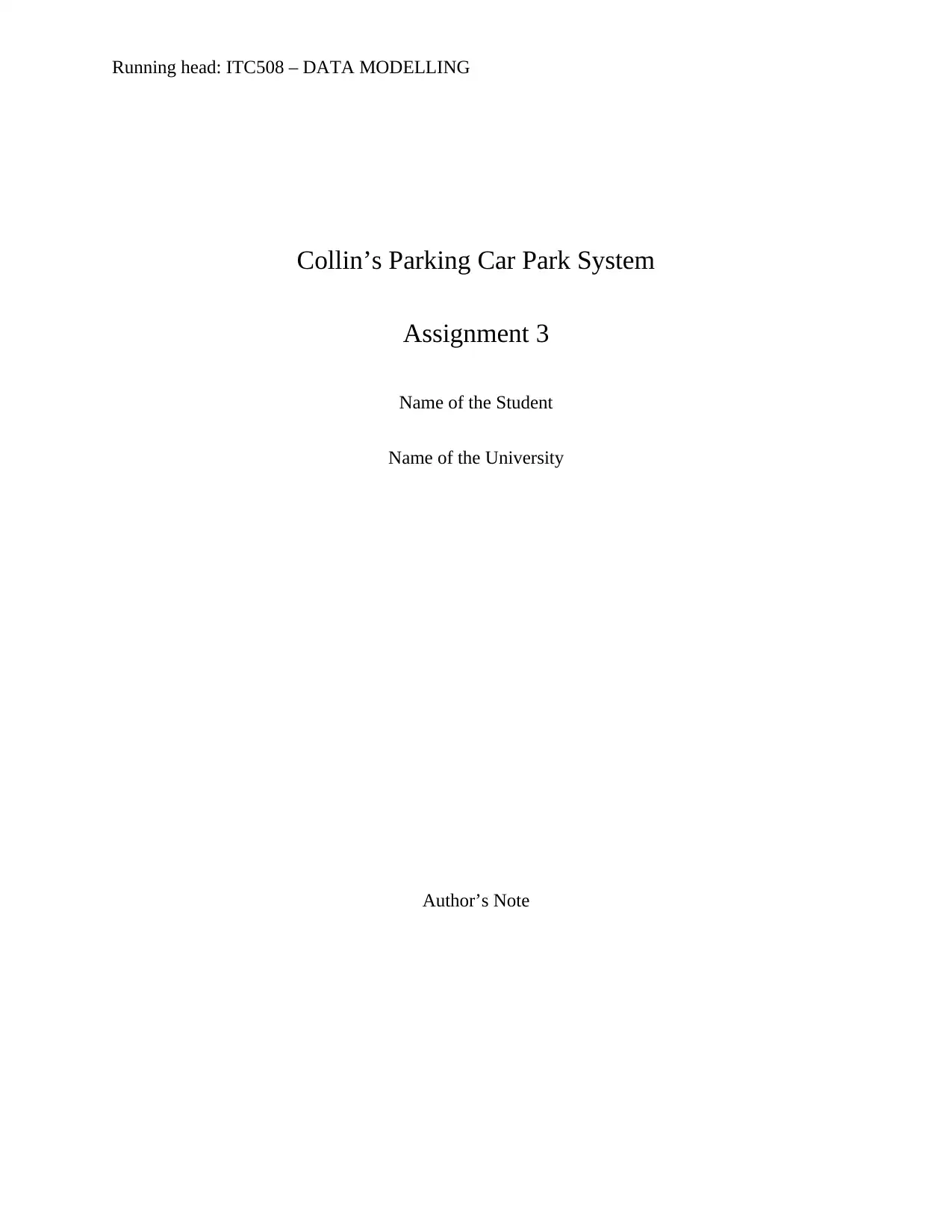
Running head: ITC508 – DATA MODELLING
Collin’s Parking Car Park System
Assignment 3
Name of the Student
Name of the University
Author’s Note
Collin’s Parking Car Park System
Assignment 3
Name of the Student
Name of the University
Author’s Note
Paraphrase This Document
Need a fresh take? Get an instant paraphrase of this document with our AI Paraphraser
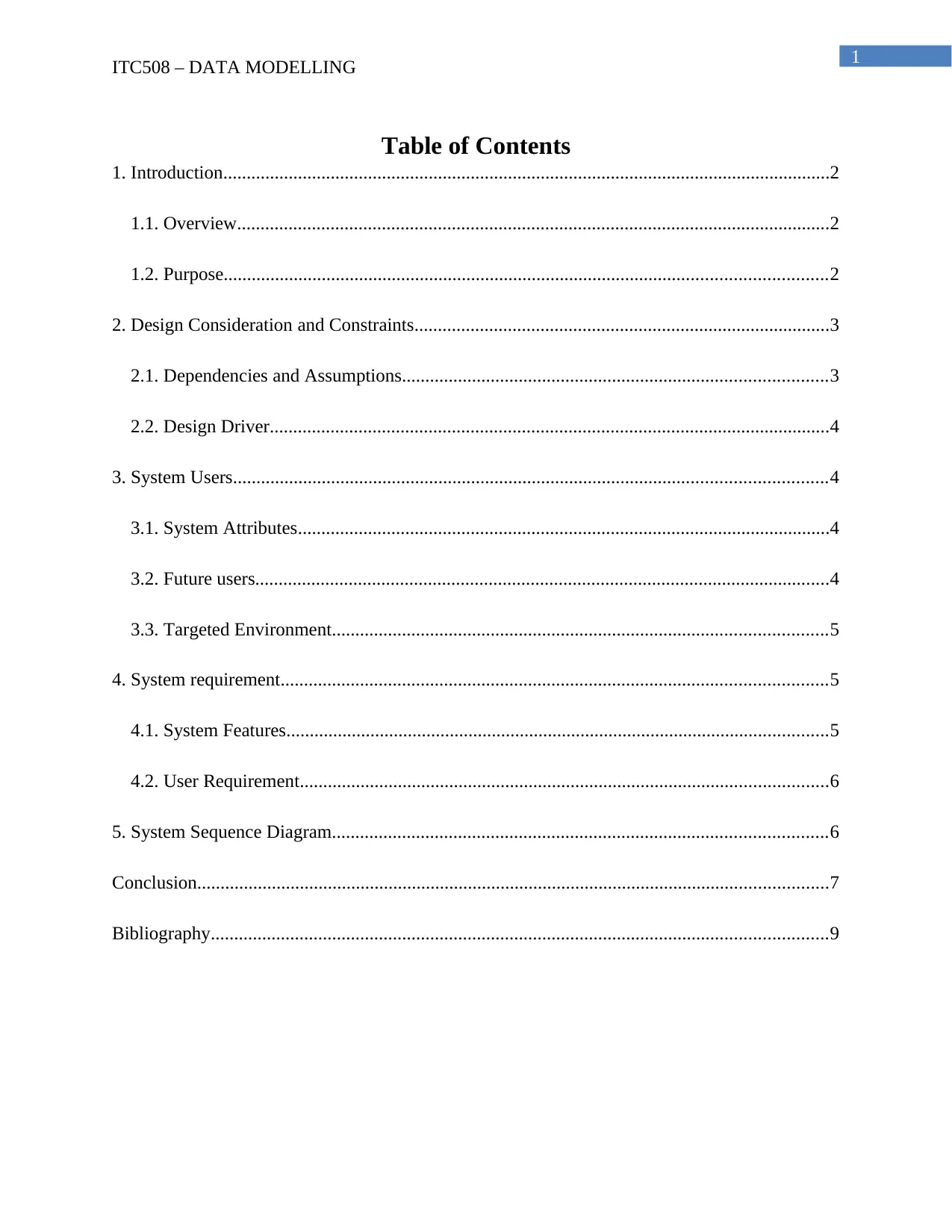
1
ITC508 – DATA MODELLING
Table of Contents
1. Introduction..................................................................................................................................2
1.1. Overview...............................................................................................................................2
1.2. Purpose.................................................................................................................................2
2. Design Consideration and Constraints.........................................................................................3
2.1. Dependencies and Assumptions...........................................................................................3
2.2. Design Driver........................................................................................................................4
3. System Users...............................................................................................................................4
3.1. System Attributes..................................................................................................................4
3.2. Future users...........................................................................................................................4
3.3. Targeted Environment..........................................................................................................5
4. System requirement.....................................................................................................................5
4.1. System Features....................................................................................................................5
4.2. User Requirement.................................................................................................................6
5. System Sequence Diagram..........................................................................................................6
Conclusion.......................................................................................................................................7
Bibliography....................................................................................................................................9
ITC508 – DATA MODELLING
Table of Contents
1. Introduction..................................................................................................................................2
1.1. Overview...............................................................................................................................2
1.2. Purpose.................................................................................................................................2
2. Design Consideration and Constraints.........................................................................................3
2.1. Dependencies and Assumptions...........................................................................................3
2.2. Design Driver........................................................................................................................4
3. System Users...............................................................................................................................4
3.1. System Attributes..................................................................................................................4
3.2. Future users...........................................................................................................................4
3.3. Targeted Environment..........................................................................................................5
4. System requirement.....................................................................................................................5
4.1. System Features....................................................................................................................5
4.2. User Requirement.................................................................................................................6
5. System Sequence Diagram..........................................................................................................6
Conclusion.......................................................................................................................................7
Bibliography....................................................................................................................................9
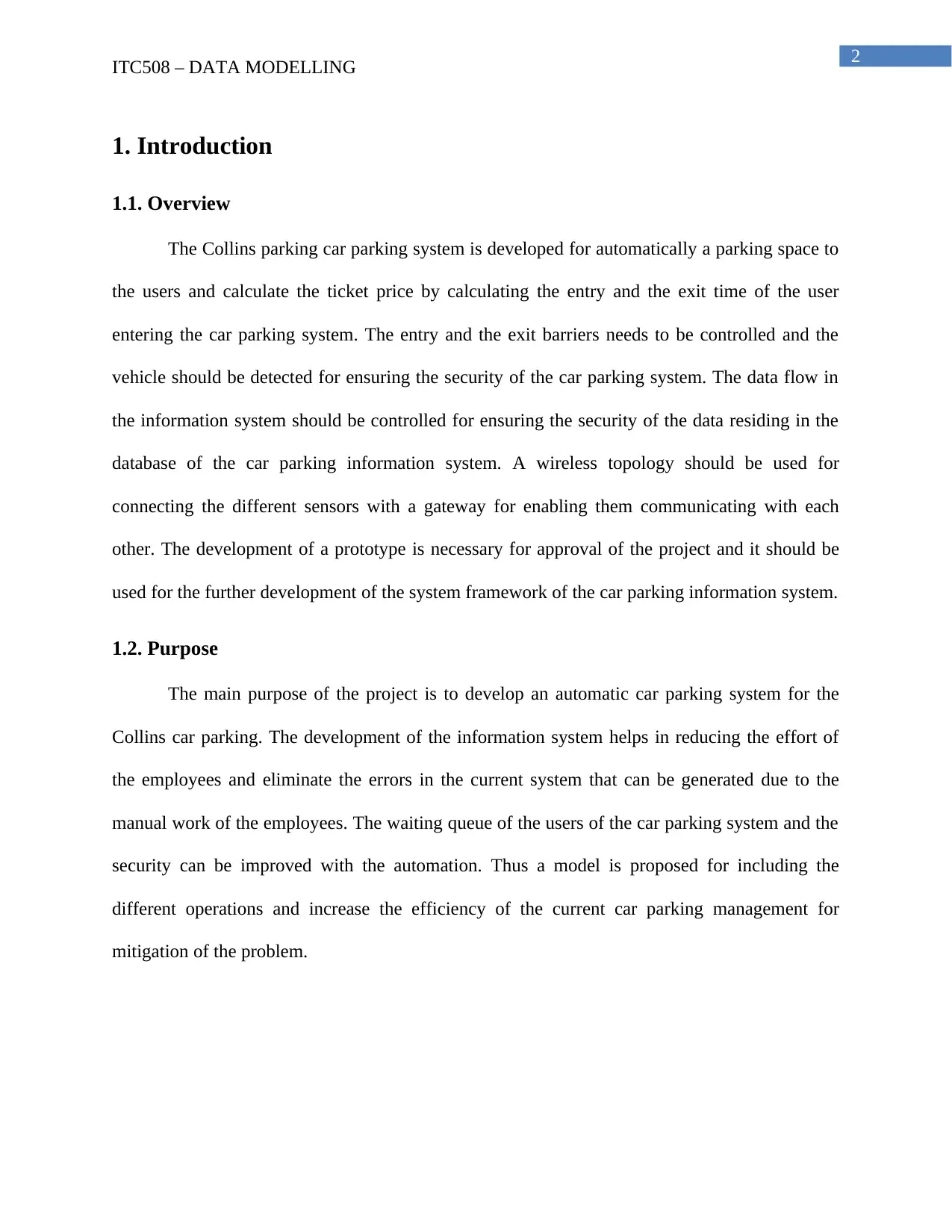
2
ITC508 – DATA MODELLING
1. Introduction
1.1. Overview
The Collins parking car parking system is developed for automatically a parking space to
the users and calculate the ticket price by calculating the entry and the exit time of the user
entering the car parking system. The entry and the exit barriers needs to be controlled and the
vehicle should be detected for ensuring the security of the car parking system. The data flow in
the information system should be controlled for ensuring the security of the data residing in the
database of the car parking information system. A wireless topology should be used for
connecting the different sensors with a gateway for enabling them communicating with each
other. The development of a prototype is necessary for approval of the project and it should be
used for the further development of the system framework of the car parking information system.
1.2. Purpose
The main purpose of the project is to develop an automatic car parking system for the
Collins car parking. The development of the information system helps in reducing the effort of
the employees and eliminate the errors in the current system that can be generated due to the
manual work of the employees. The waiting queue of the users of the car parking system and the
security can be improved with the automation. Thus a model is proposed for including the
different operations and increase the efficiency of the current car parking management for
mitigation of the problem.
ITC508 – DATA MODELLING
1. Introduction
1.1. Overview
The Collins parking car parking system is developed for automatically a parking space to
the users and calculate the ticket price by calculating the entry and the exit time of the user
entering the car parking system. The entry and the exit barriers needs to be controlled and the
vehicle should be detected for ensuring the security of the car parking system. The data flow in
the information system should be controlled for ensuring the security of the data residing in the
database of the car parking information system. A wireless topology should be used for
connecting the different sensors with a gateway for enabling them communicating with each
other. The development of a prototype is necessary for approval of the project and it should be
used for the further development of the system framework of the car parking information system.
1.2. Purpose
The main purpose of the project is to develop an automatic car parking system for the
Collins car parking. The development of the information system helps in reducing the effort of
the employees and eliminate the errors in the current system that can be generated due to the
manual work of the employees. The waiting queue of the users of the car parking system and the
security can be improved with the automation. Thus a model is proposed for including the
different operations and increase the efficiency of the current car parking management for
mitigation of the problem.
⊘ This is a preview!⊘
Do you want full access?
Subscribe today to unlock all pages.

Trusted by 1+ million students worldwide
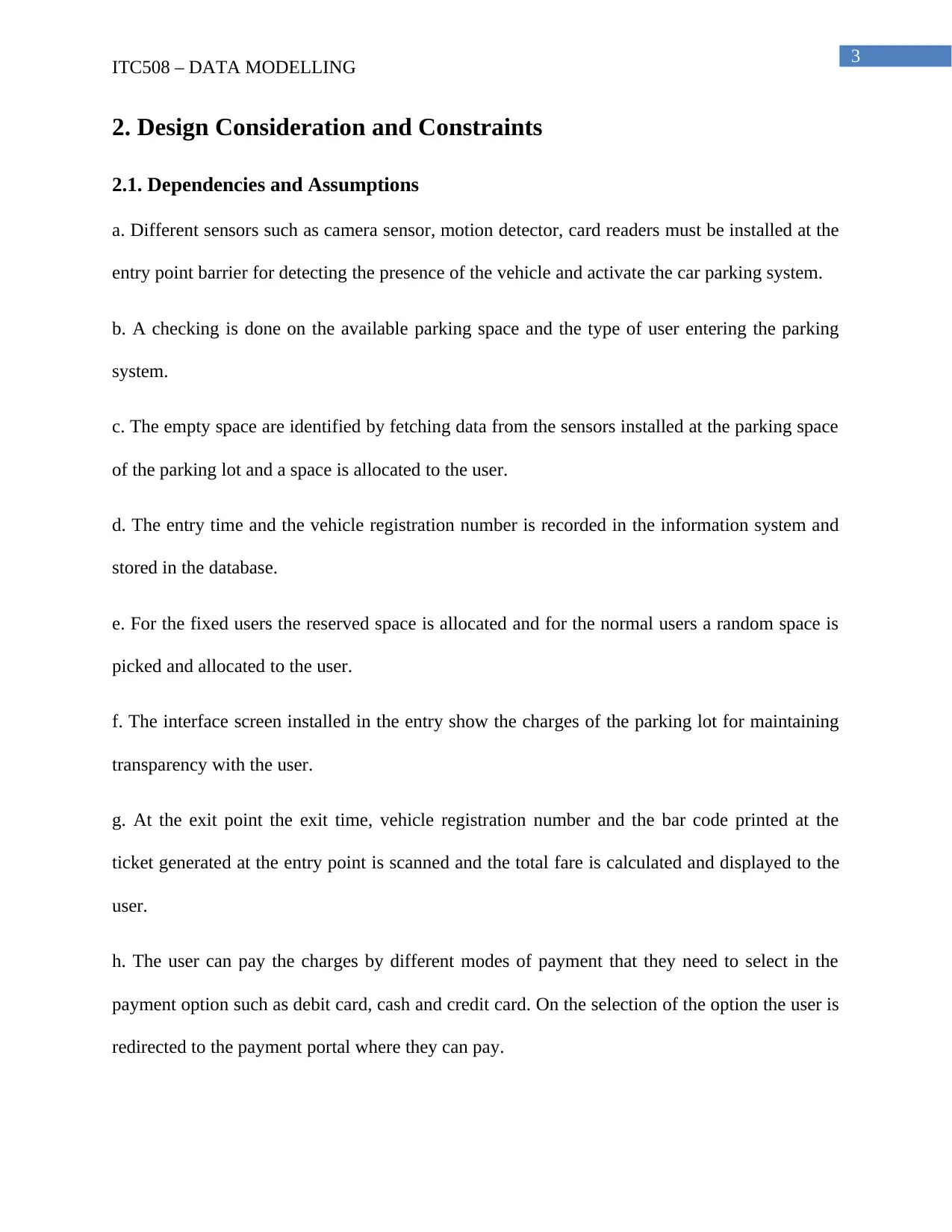
3
ITC508 – DATA MODELLING
2. Design Consideration and Constraints
2.1. Dependencies and Assumptions
a. Different sensors such as camera sensor, motion detector, card readers must be installed at the
entry point barrier for detecting the presence of the vehicle and activate the car parking system.
b. A checking is done on the available parking space and the type of user entering the parking
system.
c. The empty space are identified by fetching data from the sensors installed at the parking space
of the parking lot and a space is allocated to the user.
d. The entry time and the vehicle registration number is recorded in the information system and
stored in the database.
e. For the fixed users the reserved space is allocated and for the normal users a random space is
picked and allocated to the user.
f. The interface screen installed in the entry show the charges of the parking lot for maintaining
transparency with the user.
g. At the exit point the exit time, vehicle registration number and the bar code printed at the
ticket generated at the entry point is scanned and the total fare is calculated and displayed to the
user.
h. The user can pay the charges by different modes of payment that they need to select in the
payment option such as debit card, cash and credit card. On the selection of the option the user is
redirected to the payment portal where they can pay.
ITC508 – DATA MODELLING
2. Design Consideration and Constraints
2.1. Dependencies and Assumptions
a. Different sensors such as camera sensor, motion detector, card readers must be installed at the
entry point barrier for detecting the presence of the vehicle and activate the car parking system.
b. A checking is done on the available parking space and the type of user entering the parking
system.
c. The empty space are identified by fetching data from the sensors installed at the parking space
of the parking lot and a space is allocated to the user.
d. The entry time and the vehicle registration number is recorded in the information system and
stored in the database.
e. For the fixed users the reserved space is allocated and for the normal users a random space is
picked and allocated to the user.
f. The interface screen installed in the entry show the charges of the parking lot for maintaining
transparency with the user.
g. At the exit point the exit time, vehicle registration number and the bar code printed at the
ticket generated at the entry point is scanned and the total fare is calculated and displayed to the
user.
h. The user can pay the charges by different modes of payment that they need to select in the
payment option such as debit card, cash and credit card. On the selection of the option the user is
redirected to the payment portal where they can pay.
Paraphrase This Document
Need a fresh take? Get an instant paraphrase of this document with our AI Paraphraser
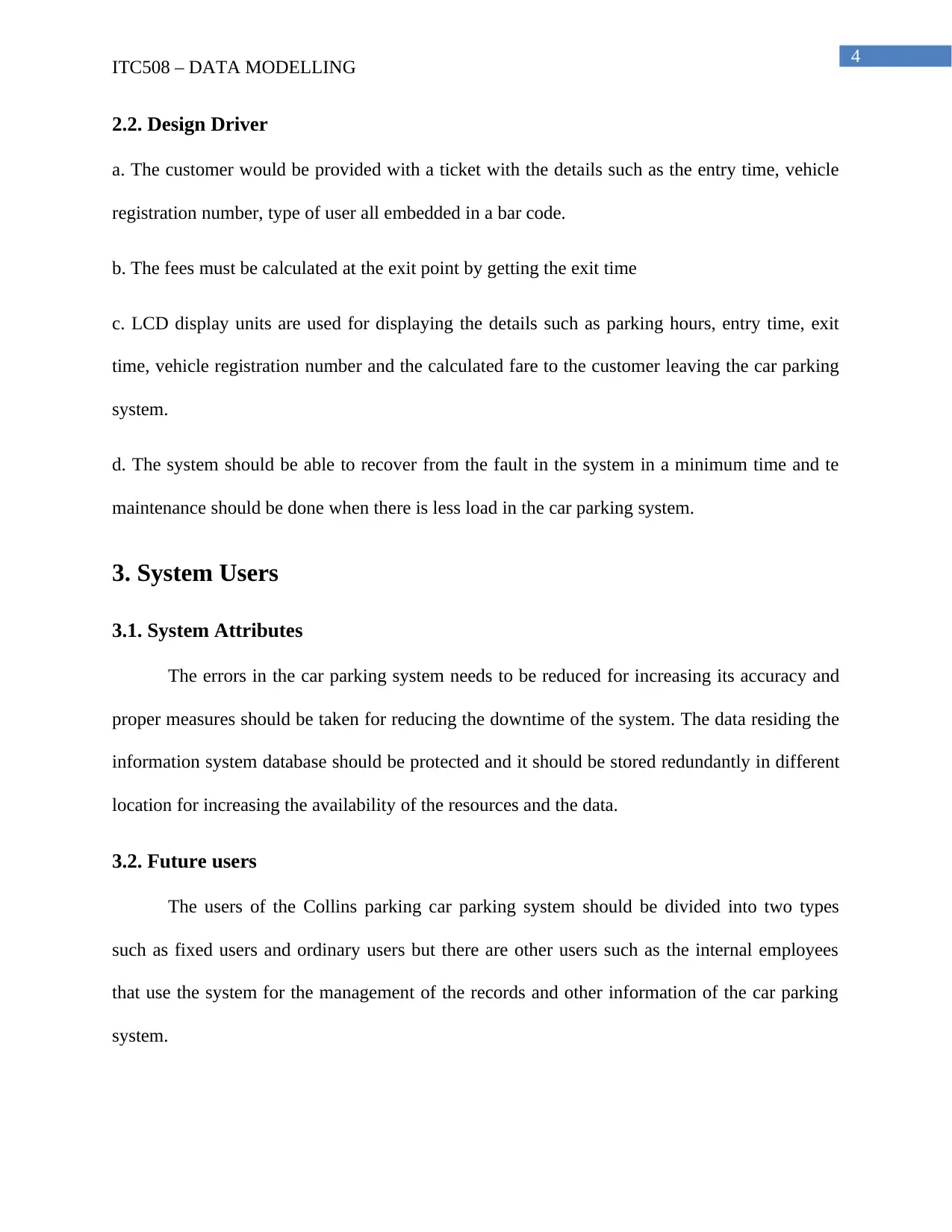
4
ITC508 – DATA MODELLING
2.2. Design Driver
a. The customer would be provided with a ticket with the details such as the entry time, vehicle
registration number, type of user all embedded in a bar code.
b. The fees must be calculated at the exit point by getting the exit time
c. LCD display units are used for displaying the details such as parking hours, entry time, exit
time, vehicle registration number and the calculated fare to the customer leaving the car parking
system.
d. The system should be able to recover from the fault in the system in a minimum time and te
maintenance should be done when there is less load in the car parking system.
3. System Users
3.1. System Attributes
The errors in the car parking system needs to be reduced for increasing its accuracy and
proper measures should be taken for reducing the downtime of the system. The data residing the
information system database should be protected and it should be stored redundantly in different
location for increasing the availability of the resources and the data.
3.2. Future users
The users of the Collins parking car parking system should be divided into two types
such as fixed users and ordinary users but there are other users such as the internal employees
that use the system for the management of the records and other information of the car parking
system.
ITC508 – DATA MODELLING
2.2. Design Driver
a. The customer would be provided with a ticket with the details such as the entry time, vehicle
registration number, type of user all embedded in a bar code.
b. The fees must be calculated at the exit point by getting the exit time
c. LCD display units are used for displaying the details such as parking hours, entry time, exit
time, vehicle registration number and the calculated fare to the customer leaving the car parking
system.
d. The system should be able to recover from the fault in the system in a minimum time and te
maintenance should be done when there is less load in the car parking system.
3. System Users
3.1. System Attributes
The errors in the car parking system needs to be reduced for increasing its accuracy and
proper measures should be taken for reducing the downtime of the system. The data residing the
information system database should be protected and it should be stored redundantly in different
location for increasing the availability of the resources and the data.
3.2. Future users
The users of the Collins parking car parking system should be divided into two types
such as fixed users and ordinary users but there are other users such as the internal employees
that use the system for the management of the records and other information of the car parking
system.
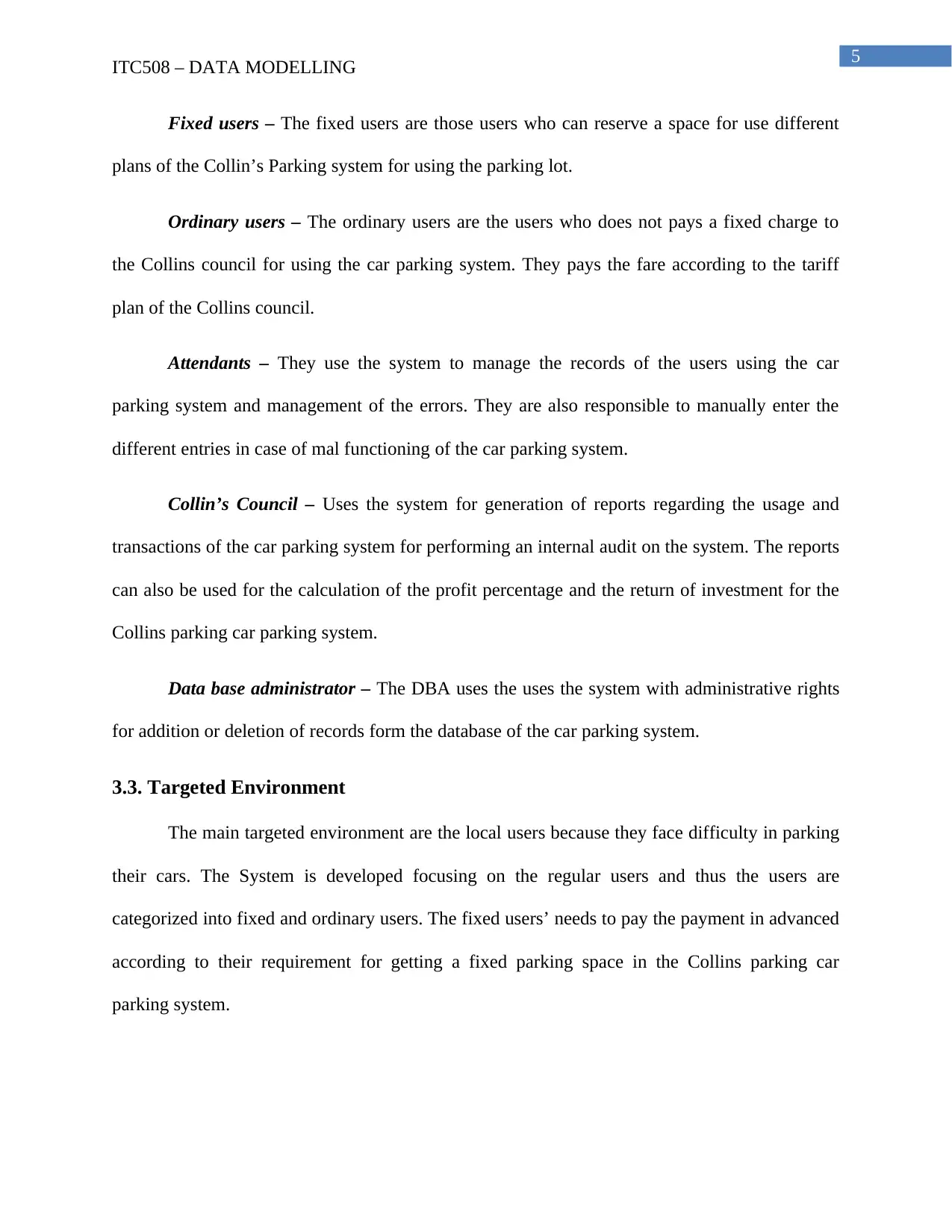
5
ITC508 – DATA MODELLING
Fixed users – The fixed users are those users who can reserve a space for use different
plans of the Collin’s Parking system for using the parking lot.
Ordinary users – The ordinary users are the users who does not pays a fixed charge to
the Collins council for using the car parking system. They pays the fare according to the tariff
plan of the Collins council.
Attendants – They use the system to manage the records of the users using the car
parking system and management of the errors. They are also responsible to manually enter the
different entries in case of mal functioning of the car parking system.
Collin’s Council – Uses the system for generation of reports regarding the usage and
transactions of the car parking system for performing an internal audit on the system. The reports
can also be used for the calculation of the profit percentage and the return of investment for the
Collins parking car parking system.
Data base administrator – The DBA uses the uses the system with administrative rights
for addition or deletion of records form the database of the car parking system.
3.3. Targeted Environment
The main targeted environment are the local users because they face difficulty in parking
their cars. The System is developed focusing on the regular users and thus the users are
categorized into fixed and ordinary users. The fixed users’ needs to pay the payment in advanced
according to their requirement for getting a fixed parking space in the Collins parking car
parking system.
ITC508 – DATA MODELLING
Fixed users – The fixed users are those users who can reserve a space for use different
plans of the Collin’s Parking system for using the parking lot.
Ordinary users – The ordinary users are the users who does not pays a fixed charge to
the Collins council for using the car parking system. They pays the fare according to the tariff
plan of the Collins council.
Attendants – They use the system to manage the records of the users using the car
parking system and management of the errors. They are also responsible to manually enter the
different entries in case of mal functioning of the car parking system.
Collin’s Council – Uses the system for generation of reports regarding the usage and
transactions of the car parking system for performing an internal audit on the system. The reports
can also be used for the calculation of the profit percentage and the return of investment for the
Collins parking car parking system.
Data base administrator – The DBA uses the uses the system with administrative rights
for addition or deletion of records form the database of the car parking system.
3.3. Targeted Environment
The main targeted environment are the local users because they face difficulty in parking
their cars. The System is developed focusing on the regular users and thus the users are
categorized into fixed and ordinary users. The fixed users’ needs to pay the payment in advanced
according to their requirement for getting a fixed parking space in the Collins parking car
parking system.
⊘ This is a preview!⊘
Do you want full access?
Subscribe today to unlock all pages.

Trusted by 1+ million students worldwide

6
ITC508 – DATA MODELLING
4. System requirement
4.1. System Features
A user ID should be crated for the fixed users and the details such as the recharge and the
available hours should be recorded under specific table for management of the data of the fixed
users. The parking time needs to be calculated automatically and for the cash transaction the
inputted amount should be checked and the balance amount should be calculated for returning
the changes to the user. The ticket should be printed to the user after analysis of the free space
available in the car parking system.
4.2. User Requirement
The fixed users’ needs to create an account and use the card at the entry time to use the
car parking system. A verification is done for checking the balance of the card and the validity
for allowing the user to enter the car parking lot. The space allocated to the user is retrieved from
the database and again allocated to the user. The ordinary customer needs to press a button for
printing the ticket from the entry barrier installed in the car parking system.
5. System Sequence Diagram
The system sequence diagram is created for the demonstration of the entry sequence of a
vehicle in Collins parking car parking system. Here the main actors are the customer and the
system are the car parking, sensor, card readers, card validator, barrier and entering the car park.
The sequence of the flow of the messages between the different actors are demonstrated with the
help of the sequence diagram. The sequence diagram is used for the demonstration of the use
case in visual format and the logic behind the actors are demonstrated in the sequence diagram
for performing a specific task.
ITC508 – DATA MODELLING
4. System requirement
4.1. System Features
A user ID should be crated for the fixed users and the details such as the recharge and the
available hours should be recorded under specific table for management of the data of the fixed
users. The parking time needs to be calculated automatically and for the cash transaction the
inputted amount should be checked and the balance amount should be calculated for returning
the changes to the user. The ticket should be printed to the user after analysis of the free space
available in the car parking system.
4.2. User Requirement
The fixed users’ needs to create an account and use the card at the entry time to use the
car parking system. A verification is done for checking the balance of the card and the validity
for allowing the user to enter the car parking lot. The space allocated to the user is retrieved from
the database and again allocated to the user. The ordinary customer needs to press a button for
printing the ticket from the entry barrier installed in the car parking system.
5. System Sequence Diagram
The system sequence diagram is created for the demonstration of the entry sequence of a
vehicle in Collins parking car parking system. Here the main actors are the customer and the
system are the car parking, sensor, card readers, card validator, barrier and entering the car park.
The sequence of the flow of the messages between the different actors are demonstrated with the
help of the sequence diagram. The sequence diagram is used for the demonstration of the use
case in visual format and the logic behind the actors are demonstrated in the sequence diagram
for performing a specific task.
Paraphrase This Document
Need a fresh take? Get an instant paraphrase of this document with our AI Paraphraser

7
ITC508 – DATA MODELLING
The following sequence diagram is created for the demonstration of the entry sequence of
the car. The flow of the information between the different system modules and the users are
represented in the sequence diagram. This helps the software development team to identify the
interaction between the actor and the system and create the functional module depending on it.
Figure 1: Entry Sequence diagram
(Source: Created by author)
Conclusion
From the above report it can be concluded that with the development of the system
sequence diagram for the Collin’s parking car parking system the errors in the final information
ITC508 – DATA MODELLING
The following sequence diagram is created for the demonstration of the entry sequence of
the car. The flow of the information between the different system modules and the users are
represented in the sequence diagram. This helps the software development team to identify the
interaction between the actor and the system and create the functional module depending on it.
Figure 1: Entry Sequence diagram
(Source: Created by author)
Conclusion
From the above report it can be concluded that with the development of the system
sequence diagram for the Collin’s parking car parking system the errors in the final information

8
ITC508 – DATA MODELLING
system can be reduced. It can also facilitate the joint application development and large group of
users can be involved in the development process and shorten the development time. The
sequence diagram is created by gathering information from different sources such as
arrangement of interviews with the stake holders, creation of brain storming session between the
development team for identification of the functional requirement. The use case should be
developed for clarification of the requirement and identification of the flow of the information
between the entities. The sequence diagram is created for the demonstration of the flow of the
message sequence between the actor and the system components required for the development of
the information system.
ITC508 – DATA MODELLING
system can be reduced. It can also facilitate the joint application development and large group of
users can be involved in the development process and shorten the development time. The
sequence diagram is created by gathering information from different sources such as
arrangement of interviews with the stake holders, creation of brain storming session between the
development team for identification of the functional requirement. The use case should be
developed for clarification of the requirement and identification of the flow of the information
between the entities. The sequence diagram is created for the demonstration of the flow of the
message sequence between the actor and the system components required for the development of
the information system.
⊘ This is a preview!⊘
Do you want full access?
Subscribe today to unlock all pages.

Trusted by 1+ million students worldwide
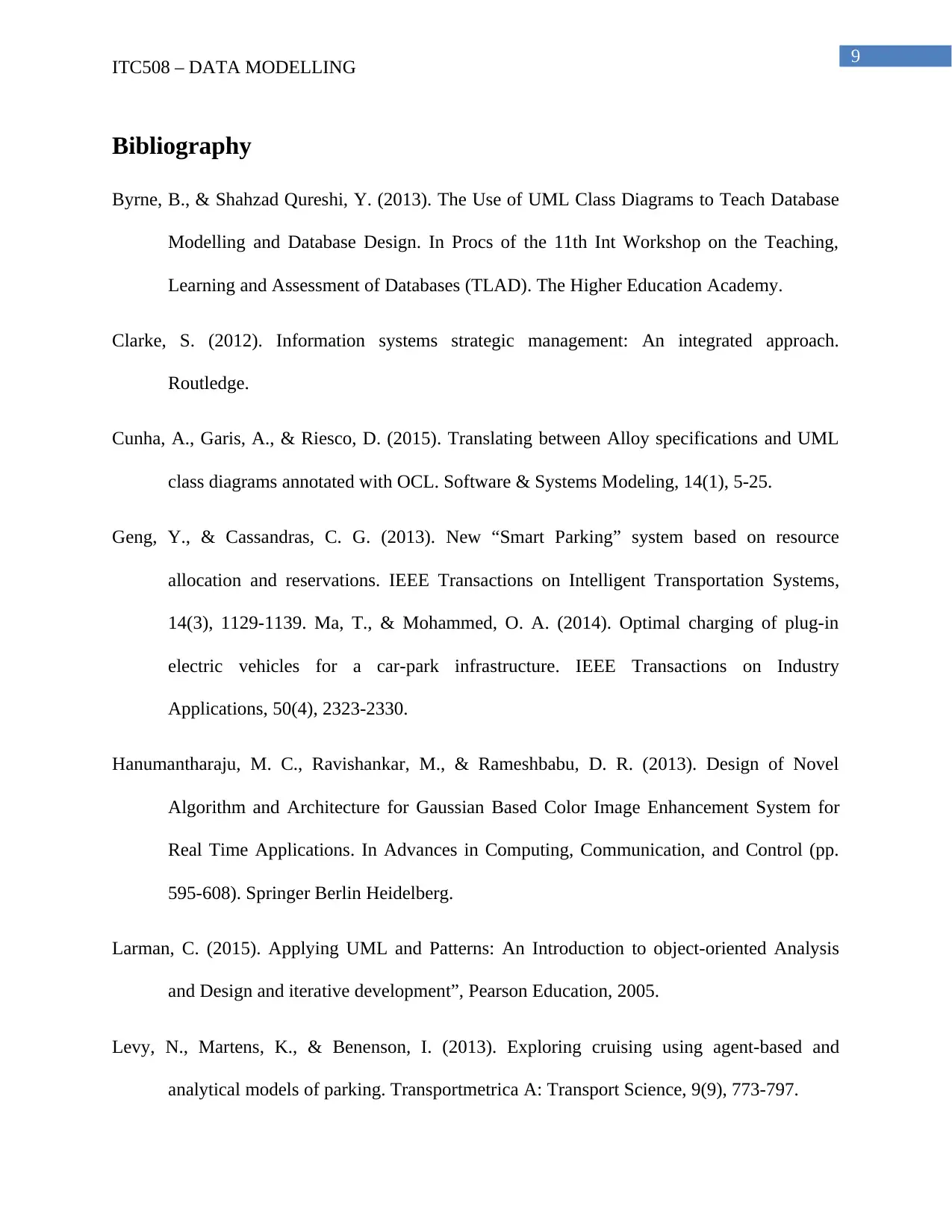
9
ITC508 – DATA MODELLING
Bibliography
Byrne, B., & Shahzad Qureshi, Y. (2013). The Use of UML Class Diagrams to Teach Database
Modelling and Database Design. In Procs of the 11th Int Workshop on the Teaching,
Learning and Assessment of Databases (TLAD). The Higher Education Academy.
Clarke, S. (2012). Information systems strategic management: An integrated approach.
Routledge.
Cunha, A., Garis, A., & Riesco, D. (2015). Translating between Alloy specifications and UML
class diagrams annotated with OCL. Software & Systems Modeling, 14(1), 5-25.
Geng, Y., & Cassandras, C. G. (2013). New “Smart Parking” system based on resource
allocation and reservations. IEEE Transactions on Intelligent Transportation Systems,
14(3), 1129-1139. Ma, T., & Mohammed, O. A. (2014). Optimal charging of plug-in
electric vehicles for a car-park infrastructure. IEEE Transactions on Industry
Applications, 50(4), 2323-2330.
Hanumantharaju, M. C., Ravishankar, M., & Rameshbabu, D. R. (2013). Design of Novel
Algorithm and Architecture for Gaussian Based Color Image Enhancement System for
Real Time Applications. In Advances in Computing, Communication, and Control (pp.
595-608). Springer Berlin Heidelberg.
Larman, C. (2015). Applying UML and Patterns: An Introduction to object-oriented Analysis
and Design and iterative development”, Pearson Education, 2005.
Levy, N., Martens, K., & Benenson, I. (2013). Exploring cruising using agent-based and
analytical models of parking. Transportmetrica A: Transport Science, 9(9), 773-797.
ITC508 – DATA MODELLING
Bibliography
Byrne, B., & Shahzad Qureshi, Y. (2013). The Use of UML Class Diagrams to Teach Database
Modelling and Database Design. In Procs of the 11th Int Workshop on the Teaching,
Learning and Assessment of Databases (TLAD). The Higher Education Academy.
Clarke, S. (2012). Information systems strategic management: An integrated approach.
Routledge.
Cunha, A., Garis, A., & Riesco, D. (2015). Translating between Alloy specifications and UML
class diagrams annotated with OCL. Software & Systems Modeling, 14(1), 5-25.
Geng, Y., & Cassandras, C. G. (2013). New “Smart Parking” system based on resource
allocation and reservations. IEEE Transactions on Intelligent Transportation Systems,
14(3), 1129-1139. Ma, T., & Mohammed, O. A. (2014). Optimal charging of plug-in
electric vehicles for a car-park infrastructure. IEEE Transactions on Industry
Applications, 50(4), 2323-2330.
Hanumantharaju, M. C., Ravishankar, M., & Rameshbabu, D. R. (2013). Design of Novel
Algorithm and Architecture for Gaussian Based Color Image Enhancement System for
Real Time Applications. In Advances in Computing, Communication, and Control (pp.
595-608). Springer Berlin Heidelberg.
Larman, C. (2015). Applying UML and Patterns: An Introduction to object-oriented Analysis
and Design and iterative development”, Pearson Education, 2005.
Levy, N., Martens, K., & Benenson, I. (2013). Exploring cruising using agent-based and
analytical models of parking. Transportmetrica A: Transport Science, 9(9), 773-797.
Paraphrase This Document
Need a fresh take? Get an instant paraphrase of this document with our AI Paraphraser
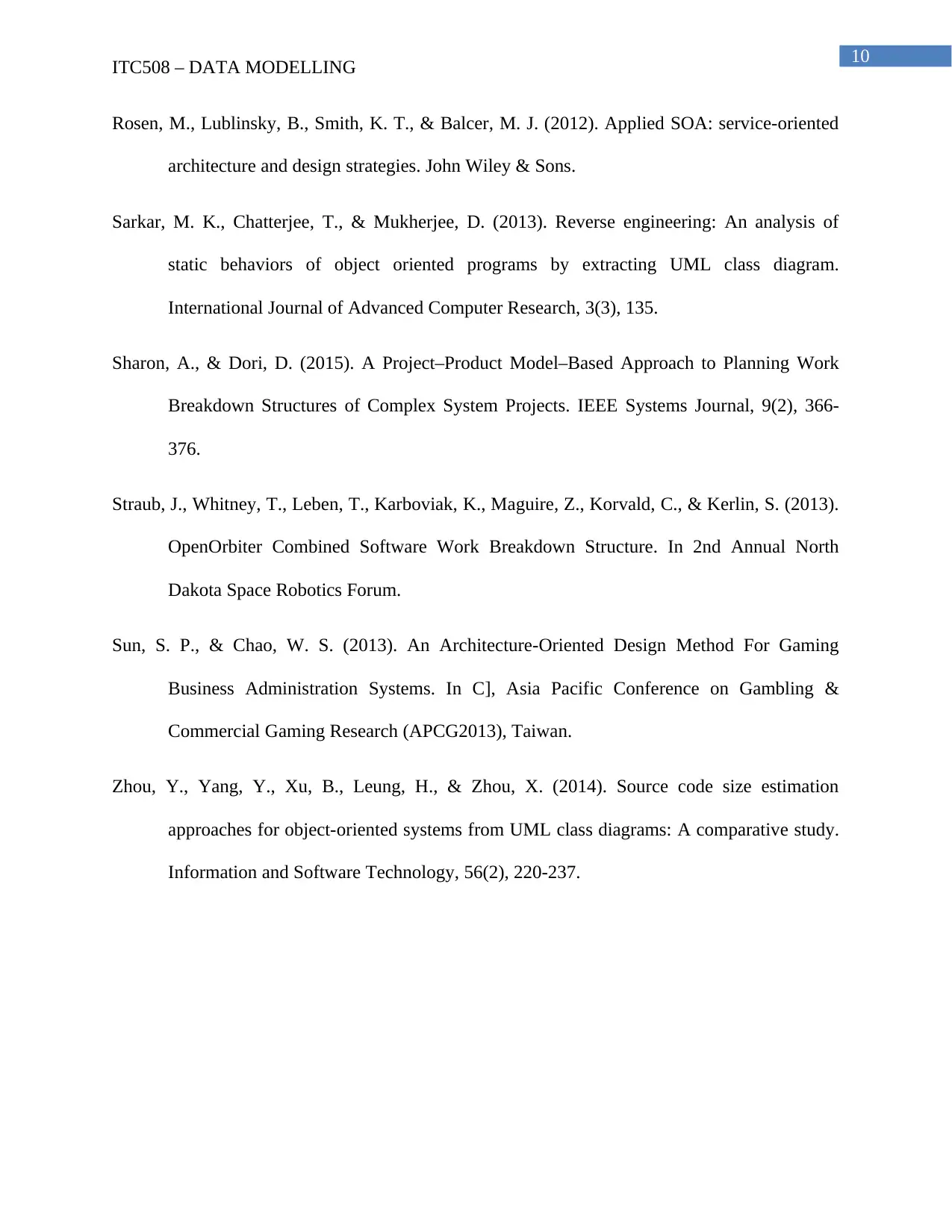
10
ITC508 – DATA MODELLING
Rosen, M., Lublinsky, B., Smith, K. T., & Balcer, M. J. (2012). Applied SOA: service-oriented
architecture and design strategies. John Wiley & Sons.
Sarkar, M. K., Chatterjee, T., & Mukherjee, D. (2013). Reverse engineering: An analysis of
static behaviors of object oriented programs by extracting UML class diagram.
International Journal of Advanced Computer Research, 3(3), 135.
Sharon, A., & Dori, D. (2015). A Project–Product Model–Based Approach to Planning Work
Breakdown Structures of Complex System Projects. IEEE Systems Journal, 9(2), 366-
376.
Straub, J., Whitney, T., Leben, T., Karboviak, K., Maguire, Z., Korvald, C., & Kerlin, S. (2013).
OpenOrbiter Combined Software Work Breakdown Structure. In 2nd Annual North
Dakota Space Robotics Forum.
Sun, S. P., & Chao, W. S. (2013). An Architecture-Oriented Design Method For Gaming
Business Administration Systems. In C], Asia Pacific Conference on Gambling &
Commercial Gaming Research (APCG2013), Taiwan.
Zhou, Y., Yang, Y., Xu, B., Leung, H., & Zhou, X. (2014). Source code size estimation
approaches for object-oriented systems from UML class diagrams: A comparative study.
Information and Software Technology, 56(2), 220-237.
ITC508 – DATA MODELLING
Rosen, M., Lublinsky, B., Smith, K. T., & Balcer, M. J. (2012). Applied SOA: service-oriented
architecture and design strategies. John Wiley & Sons.
Sarkar, M. K., Chatterjee, T., & Mukherjee, D. (2013). Reverse engineering: An analysis of
static behaviors of object oriented programs by extracting UML class diagram.
International Journal of Advanced Computer Research, 3(3), 135.
Sharon, A., & Dori, D. (2015). A Project–Product Model–Based Approach to Planning Work
Breakdown Structures of Complex System Projects. IEEE Systems Journal, 9(2), 366-
376.
Straub, J., Whitney, T., Leben, T., Karboviak, K., Maguire, Z., Korvald, C., & Kerlin, S. (2013).
OpenOrbiter Combined Software Work Breakdown Structure. In 2nd Annual North
Dakota Space Robotics Forum.
Sun, S. P., & Chao, W. S. (2013). An Architecture-Oriented Design Method For Gaming
Business Administration Systems. In C], Asia Pacific Conference on Gambling &
Commercial Gaming Research (APCG2013), Taiwan.
Zhou, Y., Yang, Y., Xu, B., Leung, H., & Zhou, X. (2014). Source code size estimation
approaches for object-oriented systems from UML class diagrams: A comparative study.
Information and Software Technology, 56(2), 220-237.
1 out of 11
Related Documents
Your All-in-One AI-Powered Toolkit for Academic Success.
+13062052269
info@desklib.com
Available 24*7 on WhatsApp / Email
![[object Object]](/_next/static/media/star-bottom.7253800d.svg)
Unlock your academic potential
Copyright © 2020–2025 A2Z Services. All Rights Reserved. Developed and managed by ZUCOL.




